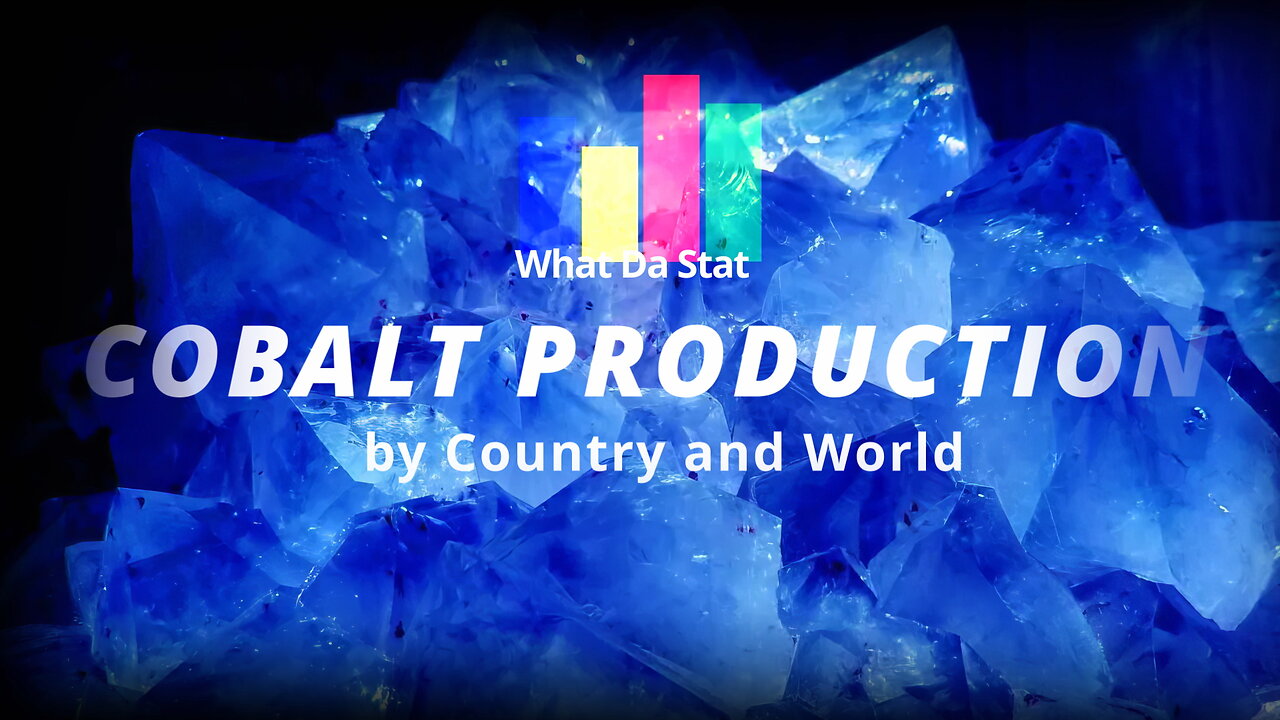Premium Only Content

Cobalt Production by Country and World 1995-2022
This bar chart race shows the production of cobalt by country/territory and world from 1995 to 2022, measured in metric tonnes.
Cobalt is a vital industrial metal with diverse applications, primarily in the manufacturing of rechargeable batteries, superalloys for aerospace and gas turbines, and catalysts in the petrochemical industry. Here's a summary of cobalt production and its global trends from 1995 to 2021:
1995-2005: In the late 1990s and early 2000s, cobalt production was relatively stable, with primary mining operations mainly concentrated in the Democratic Republic of Congo (DRC) and a few other countries. This period saw modest growth in cobalt demand, primarily driven by the burgeoning mobile phone industry.
Mid-2000s: A surge in demand for portable electronic devices and the advent of electric vehicles (EVs) began to drive cobalt demand significantly. Prices started to rise as concerns about supply constraints grew. The DRC continued to dominate global cobalt production.
2010s: Cobalt production and prices experienced significant fluctuations during this decade. High prices and ethical concerns over mining practices in the DRC prompted efforts to diversify cobalt sources. Exploration in countries like Canada, Australia, and Russia gained momentum. Recycling of cobalt from end-of-life batteries also became more common.
Late 2010s: As EV adoption continued to grow, cobalt became a focal point of supply chain concerns due to its geopolitical risks and ethical issues surrounding its extraction. Battery manufacturers began to develop cobalt-reduced and cobalt-free battery technologies to mitigate supply chain risks.
2020s: The cobalt market experienced notable shifts. Cobalt prices remained relatively volatile, driven by factors such as fluctuations in EV demand, geopolitical tensions, and supply chain concerns. Efforts to reduce cobalt in batteries continued, and recycling technologies advanced, contributing to a more sustainable cobalt supply chain.
Throughout this period, the Democratic Republic of Congo remained the world's leading cobalt producer, supplying over 60% of global production. However, concerns persisted regarding labor conditions, child labor, and environmental impacts associated with cobalt mining in the DRC. Efforts to address these issues, such as responsible sourcing initiatives and certification programs, gained traction.
In conclusion, cobalt production has evolved significantly since 1995, driven by the expanding use of cobalt in batteries and other industries. The sector has faced challenges related to supply chain ethics, price volatility, and efforts to reduce dependency on cobalt. The future of cobalt production will likely continue to be shaped by technological innovations, sustainability efforts, and shifts in demand, especially from the growing electric vehicle industry.
Data source: Energy Institute Statistical Review of World Energy (2023)
Music: DEVCYGR - 3v01uTi0n
https://soundcloud.com/gbo-gr-cy/devcygr-3v01uti0n
DEVCYGR - 3v01uTi0n By gbo.gr.cy is licensed under a Creative Commons License
Data visualization created with flourish.studio
-
 1:26:34
1:26:34
Man in America
10 hours agoExposing the Cover-Up That Could Collapse Big Medicine: Parasites
46.1K18 -
 4:53:00
4:53:00
CHiLi XDD
6 hours agoTekken Fight Night
24.4K1 -
 9:25:57
9:25:57
ItsLancOfficial
11 hours agoFREAKY FRIDAY-GETTING FRIED-WELP! #TOTS
24.2K4 -
 1:09:11
1:09:11
Sarah Westall
7 hours agoRead the Signs: Are We Already Operating in a New Financial System? w/ Andy Schectman
37.5K7 -
 1:32:53
1:32:53
Flyover Conservatives
11 hours agoRicky Schroder Exposes How Hollywood Planted Him as a Child Star | FOC Show
47.7K9 -
 4:59:48
4:59:48
JahBlessCreates
5 hours ago🎉 TEKKEN TING, and maybe some music...
24.7K14 -
 LIVE
LIVE
GritsGG
6 hours agoTop 250 Ranked Grind! Dubulars!🫡
56 watching -
 4:31:29
4:31:29
StuffCentral
5 hours agoStar Stuffy
9.23K4 -
 6:02
6:02
Blackstone Griddles
7 hours agoPrime Rib Brisket Burgers on the Blackstone Griddle
12.4K5 -
 3:35:06
3:35:06
HELMETFIRE
5 hours ago🟢HELMETFIRE PLAYS: Silksong Part 4🟢
4.84K